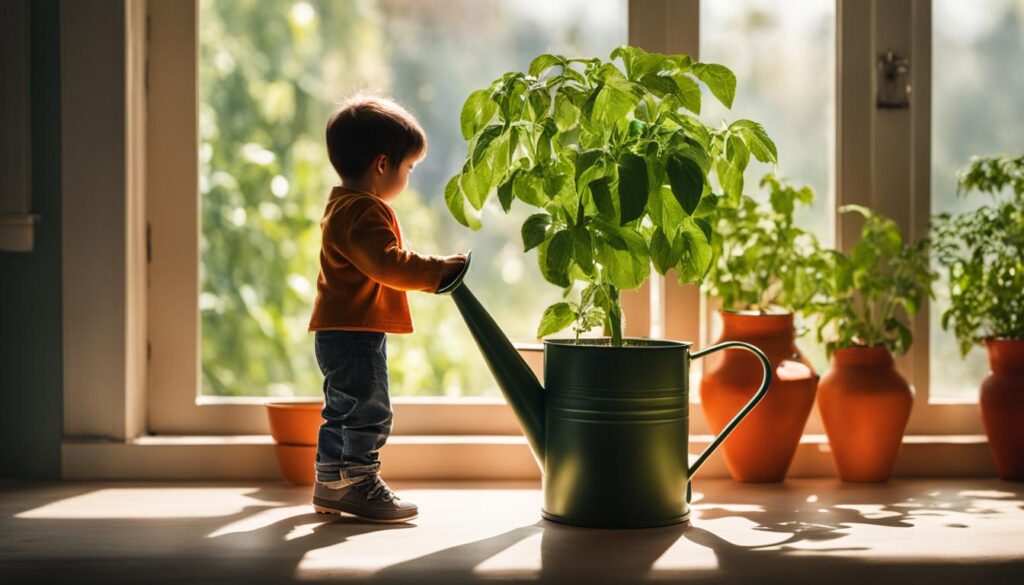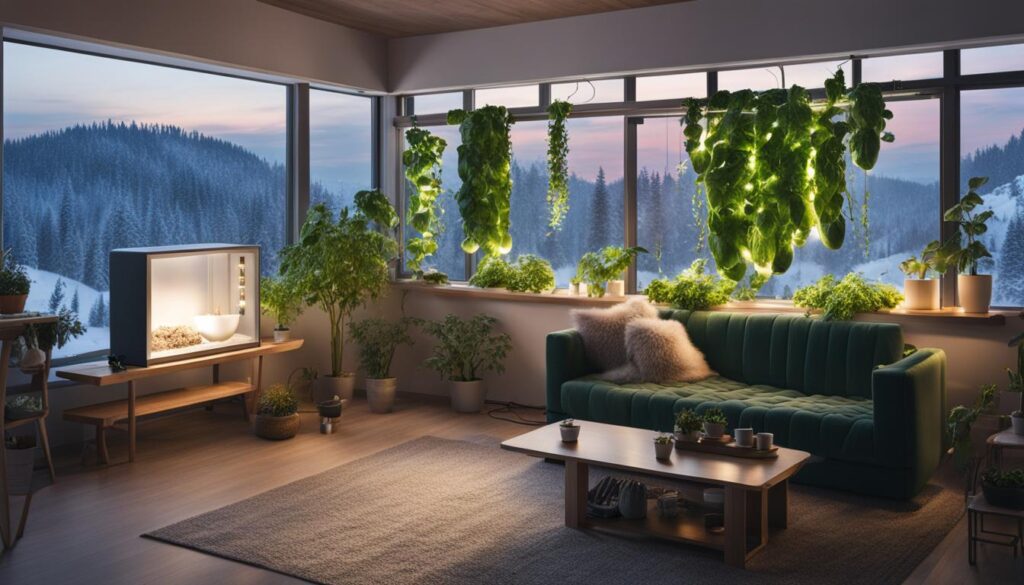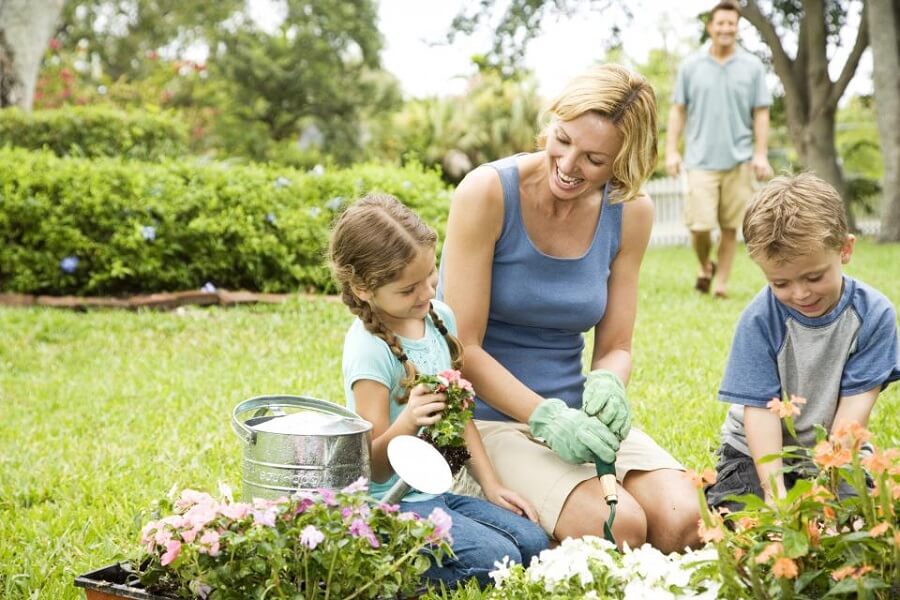Growing vegetables indoors in winter is not only possible but also a great way to have a fresh, healthy harvest all year round. With the right conditions and care, you can cultivate a variety of vegetables right in your own home. Whether you have a garden or not, you can create an indoor vegetable garden using pots and seeds. There are numerous vegetables that can be grown indoors, including tomatoes, squash, cucumbers, bell peppers, hot peppers, basil, parsley, spinach, kale, lettuce, rosemary, chives, thyme, catnip, sprouts, turnips, carrots, potatoes, and many more.
Key Takeaways:
- Winter is a suitable time to grow vegetables indoors for a fresh harvest throughout the year.
- Indoor vegetable gardens can be created using pots and seeds.
- A wide variety of vegetables can be grown indoors, including tomatoes, squash, cucumbers, bell peppers, and hot peppers.
- Proper care, sunlight, and temperature are essential for successful indoor cultivation.
- Start your indoor vegetable garden and enjoy homegrown, organic vegetables even during the cold winter months.
How to Grow Tomatoes Indoors in Winter
Tomatoes are a popular vegetable to grow indoors during the winter months. With the right techniques and care, you can enjoy a bountiful harvest of fresh tomatoes right in the comfort of your own home. Here’s a step-by-step guide on how to successfully grow tomatoes indoors in winter:
- Choose the right type of tomato: Not all tomato varieties are suitable for indoor cultivation. Opt for compact varieties such as Toy Boy, Tiny Tim, Florida Petite, and Red Robin that are well-suited for small spaces.
- Select the right container: Use unglazed pots that have good drainage. A depth of six inches is ideal for tomato plants.
- Plant the tomato seeds: Plant the tomato seeds at a depth of ¼ inch in garden soil. Ensure that the soil is well-draining and nutrient-rich.
- Provide adequate sunlight: Tomatoes need a minimum of six to eight hours of direct sunlight each day. Place them near a south-facing window or use grow lights to supplement the natural light.
- Water and fertilize regularly: Keep the soil consistently moist but not waterlogged. Water the plants when the top inch of soil feels dry. Fertilize with a balanced liquid fertilizer every two weeks.
- Prune and support the plants: As the tomato plants grow, prune off any suckers that form in the leaf axils. Use stakes or cages to support the plants and prevent them from sprawling.
- Monitor for pest and disease: Tomatoes are susceptible to pests and diseases, even when grown indoors. Regularly inspect the plants for signs of pests such as aphids or diseases such as powdery mildew. Treat as necessary.
- Harvest your tomatoes: Depending on the variety, tomatoes can take anywhere from 55 to 80 days to reach maturity. Harvest when the tomatoes are fully ripened and enjoy the taste of homegrown goodness!
By following these steps, you’ll be able to grow delicious tomatoes indoors throughout the winter season. So get your supplies ready and start your indoor tomato garden today!
Growing Squash Indoors in Winter
When it comes to growing vegetables indoors during winter, squash is a versatile and rewarding option to consider. With the right care and conditions, you can enjoy a bountiful harvest of this delicious and nutritious vegetable. Here’s a guide to help you successfully grow squash in your indoor garden.
1. Choose the Right Pot
Select an unglazed pot that is at least 12 inches deep and 24 inches in diameter. It should have drainage holes at the bottom to prevent waterlogging. This will ensure that your squash plants have enough space to grow and thrive.
2. Planting and Care
Sow at least three squash seeds in the middle of the pot, leaving enough space between them. The seeds should be planted at a depth of about 1 inch. Water the soil regularly to keep it moist, but avoid overwatering as it can lead to root rot. Place your pot in an area that receives ample sunlight or use artificial grow lights to provide the necessary light for growth.
3. Pollination
Squash plants require pollination for fruit set. If you’re growing squash indoors, you may need to manually pollinate the flowers. Gently transfer pollen from the male flowers to the female flowers using a small brush or cotton swab. This will help ensure proper fruit development.
In conclusion, growing squash indoors in winter is an exciting and rewarding endeavor. By following these tips and providing the right conditions, you can enjoy a fresh supply of this versatile vegetable all year round. Remember to choose the right pot, provide adequate care, and assist with pollination if needed. Happy gardening!
Indoor Cultivation of Cucumbers in Winter
Growing cucumbers indoors during winter can be a rewarding experience, allowing you to enjoy fresh, homegrown cucumbers even when it’s cold outside. With the right techniques and care, you can successfully cultivate cucumbers in the comfort of your own home. Here are some tips to help you grow cucumbers indoors during the winter season.
1. Choose the Right Seeds
When growing cucumbers indoors, it’s important to choose the right seeds specifically designed for indoor cultivation. Look for compact, dwarf, or bush varieties that don’t require extensive space for their vines to spread. These varieties are more suitable for container gardening and will thrive in smaller pots.
2. Use Large Pots
Cucumbers have a deep root system, so it’s crucial to provide them with enough space to grow. Use large pots that are at least 12 inches deep to accommodate the roots. Ensure that the pots have proper drainage to prevent waterlogging, as excess moisture can lead to root rot.
3. Provide Ample Sunlight and Temperature
Cucumbers require plenty of sunlight to thrive. Place your pots near a sunny window or use grow lights to provide the necessary light energy. Ideally, cucumbers need temperatures between 73 and 79°F during the day for optimal growth. Lower the temperature slightly during the night to mimic natural outdoor conditions.
4. Ensure Proper Airflow
Good airflow is essential for preventing the buildup of humidity and reducing the risk of diseases, such as powdery mildew. Place a small fan near your cucumber plants to promote air circulation. This will also help strengthen the plants’ stems and prevent them from becoming weak and leggy.
By following these tips, you can successfully grow cucumbers indoors during winter and enjoy the fresh, crisp taste of homegrown cucumbers throughout the season. Remember to water your plants regularly, provide adequate support for climbing varieties, and keep an eye out for any signs of pests or diseases. Happy gardening!
Growing Bell Peppers and Hot Peppers Indoors in Winter
Growing bell peppers and hot peppers indoors during winter is a rewarding way to enjoy these flavorsome vegetables all year round. With the right care and conditions, you can have a bountiful harvest of fresh peppers in the comfort of your own home. Here are some tips to help you successfully grow bell peppers and hot peppers indoors this winter.
Choosing the Right Pot and Soil
Start by selecting a suitable pot for your peppers. Opt for a pot that is at least 12 inches in diameter and has good drainage. This will ensure proper moisture control and prevent waterlogged roots. Use a well-draining soil mix that is rich in organic matter, such as a blend of vermiculite, peat moss, and coarse sand. This will provide the peppers with the necessary nutrients and aeration for healthy growth.
Planting and Care
Plant two or three pepper seeds in each pot, planting them at a depth of around ¼ inch. Place the pots in a room that maintains a constant temperature between 65 and 75°F. Peppers thrive in warm conditions, so ensure they receive ample sunlight for at least 6-8 hours a day. If natural sunlight is limited, consider using fluorescent grow lights to supplement the light requirements. Water the peppers regularly, ensuring the soil remains moist but not waterlogged.
Harvesting and Enjoying
As your bell peppers and hot peppers grow, you will notice the fruits reaching maturity. Harvest the peppers when they have reached their desired size and color. To encourage further production, pick the peppers regularly. Bell peppers are typically picked when they are firm and crisp, while hot peppers can be harvested when they have developed their characteristic heat. Use your homegrown peppers to add flavor and spice to your favorite dishes, or preserve them by pickling or freezing.
With these simple guidelines, you can successfully grow bell peppers and hot peppers indoors during the winter months. Enjoy the satisfaction of harvesting your own fresh, flavorful peppers, and elevate your culinary creations with homegrown produce.
Conclusion
Growing vegetables indoors in winter is a practical and rewarding way to ensure a fresh supply of produce throughout the year. By setting up an indoor vegetable garden, you can enjoy the benefits of homegrown, organic vegetables even during the cold winter months.
With a little planning and the right conditions, you can cultivate a variety of vegetables right in your own home. From tomatoes and squash to cucumbers, bell peppers, and hot peppers, there are numerous options to choose from.
Remember to provide your indoor garden with proper sunlight and maintain the required temperature for each vegetable. Additionally, regular care including watering, fertilizing, and pruning will contribute to the success of your indoor vegetable garden.
Embrace the possibilities of growing vegetables indoors and start your own indoor vegetable garden today. Experience the joy of harvesting fresh, nutritious vegetables all year round, and take pride in your self-sustainability.
How can I successfully grow vegetables indoors during the winter months?
Growing the best winter indoor veggies can be a successful venture with the right conditions. Ensure your plants receive plenty of light, whether it be from a sunny window or grow lights. Keep the temperature consistent and provide proper ventilation for healthy, thriving vegetables even during the colder months.
FAQ
Can I grow vegetables indoors in winter?
Yes, it is possible to grow vegetables indoors in winter. With the right conditions and care, you can cultivate a variety of vegetables right in your own home.
What vegetables can be grown indoors in winter?
There are numerous vegetables that can be grown indoors in winter, including tomatoes, squash, cucumbers, bell peppers, hot peppers, basil, parsley, spinach, kale, lettuce, rosemary, chives, thyme, catnip, sprouts, turnips, carrots, potatoes, and many more.
How do I grow tomatoes indoors in winter?
Use unglazed pots with good drainage and a depth of six inches. Plant the tomato seeds at a depth of ¼ inch in garden soil. Provide proper airflow and ensure sufficient sunlight for optimal growth.
Can squash be grown indoors in winter?
Yes, squash can be grown indoors in winter. Choose an unglazed pot that is about 12 inches deep and 24 inches in diameter. Plant at least three squash seeds in the middle of the pot, leaving sufficient space between them. Water regularly and provide ample sunlight or artificial light.
How can I grow cucumbers indoors during winter?
Use special seeds designed for indoor growth. Use large pots that provide enough space for the vines to climb. Cucumbers need direct sunlight and temperatures between 73 and 79°F. Ensure proper airflow and lower temperatures during the night for optimum results.
Can bell peppers and hot peppers be grown indoors in winter?
Yes, both bell peppers and hot peppers can be successfully grown in pots indoors during winter. Choose the best soil mix and plant two or three seeds in each pot. Provide direct sunlight and proper care for healthy growth.












